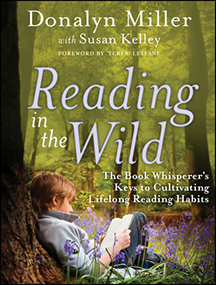Reading in the Wild
 Reading in the Wild: The Book Whisperer’s Keys to Cultivating Lifelong Reading Habits by Donalyn Miller with Susan Kelley. Published by Jossey-Bass, 2013. 304 pages.
Reading in the Wild: The Book Whisperer’s Keys to Cultivating Lifelong Reading Habits by Donalyn Miller with Susan Kelley. Published by Jossey-Bass, 2013. 304 pages.
Though clearly targeted to reading instructors, this follow-up to The Book Whisperer can be useful for anyone dedicated to turning students into readers. Reading in the Wild is a blend of the inspirational, the insightful, the illuminating, and the practical.
Why do we need another book on reading? First, Miller is not afraid to be provocative. She points out many of the activities such as dioramas and crossword puzzles and the like seem to be designed to make students hate to read. She puts forth five points that distinguish readers in the wild and supports each with community conversations, conferring points and ways to keep track of the reading life. Because she is a reading teacher, she also includes a plethora of forms to support these activities in the appendix.
And just what are the characteristics of wild readers?
1. Dedicated time
2. Wild readers self-select reading material
3. Wild readers share books and reading with other readers
4. Wild readers have reading plans
5. Wild readers show preferences
Throughout the book, Miller also includes fun sidebars that let you hear from the wild readers themselves whether they are recent students or adults. The authors provide plenty of scholarship to back up their assertions, including the relationship between number of minutes read per day and the way the student scores on standardized tests. That should get the attention of school administrators!
One of the tactics employed by the authors includes the reading itinerary which goes a step beyond a reading log, where students only list where and how long they read. This provides great insights into their reading habits.
The book also includes a section on “Fake Reading.” Knowing teachers will recognize the signs and perhaps learn a few more as Miller shows how to turn fake readers into real readers from tools for documenting it to strategies for combating it, ending with a compelling case study.
Miller recognizes that teachers’ schedules and resources are not created equal and that the information she provides can be not only inspiring but also a little daunting. The authors have a plan here too, helping teachers figure out how to work with their schedules to create a productive reading environment.
An important component for creating wild readers is to know multiple book discovery sources. Miller looks at this on the student as well as the professional level. When talking about ways to share and encourage reading, the authors provide several ideas of ways teachers and administrators can make their school a literacy hub. These ideas range from very simple, like including a reading suggestion in their email signatures, to specific ideas on how to increase children’s access to books.
Worried about the summer slide? Miller’s Book-a-Day challenge can reverse that trend. Students commit to reading one book every day of their summer vacation. Her detailed plan even comes with its own hashtag–#bookaday.
In the “wild readers show preferences” section of the book, Miller also highlights those genres which are often not preferred. She looks not only at the possible reasons for the lack of enthusiasm but also provides a framework for reintroducing them in a more positive and engaging way as well as discovery points including the Sibert list for nonfiction.
Need justification and suggestions for reading aloud to your students each day? This is supplied in Reading in the Wild. Looking for a balanced perspective on reading measurement tools? Need pointers on creating and curating an effective classroom library? These are all covered in Reading in the Wild.
Whether you are a librarian, a reading teacher, or a teacher who loves reading, Reading in the Wild can help you set loose your creativity and transform your students.
– Reviewed by Ellen Myrick
